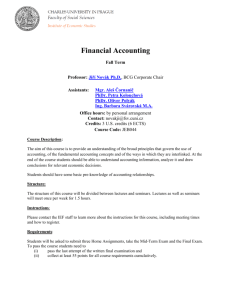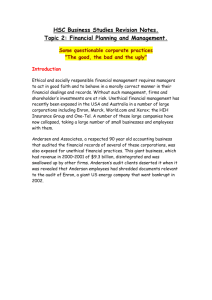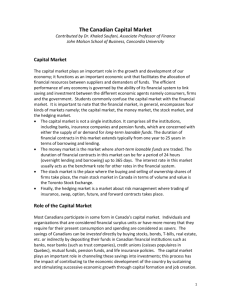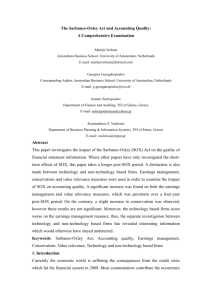Evaluating the Relationship Between Earnings Management and
advertisement
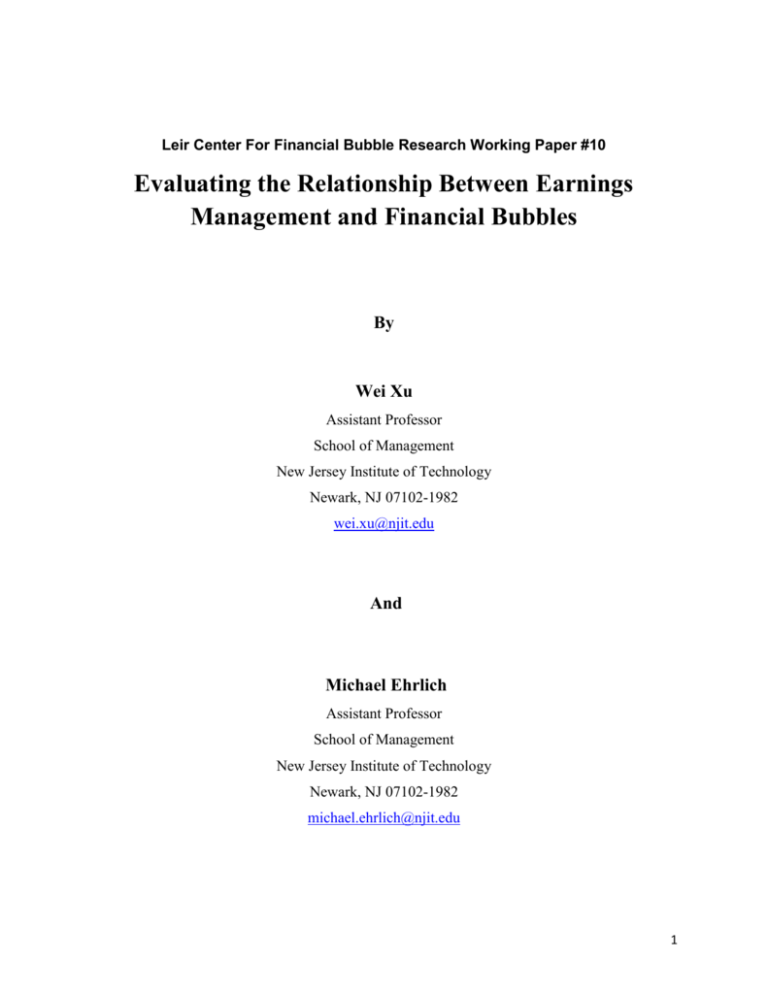
Leir Center For Financial Bubble Research Working Paper #10 Evaluating the Relationship Between Earnings Management and Financial Bubbles By Wei Xu Assistant Professor School of Management New Jersey Institute of Technology Newark, NJ 07102-1982 wei.xu@njit.edu And Michael Ehrlich Assistant Professor School of Management New Jersey Institute of Technology Newark, NJ 07102-1982 michael.ehrlich@njit.edu 1 Evaluating the Relationship Between Earnings Management and Financial Bubbles 1. Introduction When Supreme Court Justice Potter Stewart was confronted with the challenge of ruling on an 1964 obscenity case, he conceded that an objective definition of pornography was hard to produce, but “I know it when I see it”. Economists and academicians have treated financial bubbles the same way for most of recent history. Charles Kindleberger and Robert Aliber in their seminal work, Manias, Panics, and Crashes: a History of Financial Crises (1978) defined a bubble as “an upward price movement over an extended range that then implodes” (p.16) While the Kindleberger definition relies on price movements that accelerate unsustainably to identify financial bubbles, this definition ignores traditional pricing theory that suggests prices are based on the present value of expected future cash flows, also known as intrinsic value. An alternative definition suggests that a financial bubble exists when the price of an asset exceeds its intrinsic value as determined by market fundamentals. However, financial bubbles seem to have relatively long lives and the market fundamentals that determine equilibrium pricing are unobservable. For our analysis, we consolidate the two definitions by recognizing that financial bubbles are characterized by a period of rapid and steady price increases followed by a sudden and sharp collapse in prices. Since bubbles may be based on excessive optimism, the collapse would be 2 consistent with a sudden updating of information that reduced expected future cash flows. In our study, we sidestep the problem of unobservable fundamentals by recognizing an observable financial behavior that is related to financial manager’s assessment of expected future cash flows and market fundamentals, earnings management. Even more challenging than recognizing a bubble and of paramount importance to market participants are the questions of “Are we in a bubble now?” and “What should I be doing with my financial assets?” In particular, we will attempt to examine the link between earnings management and the cycle of financial bubble development. This study aims to investigate if the discretionary accounting behavior of financial managers that we call earnings management is related to the development of a bubble cycle. Specifically, we plan to investigate the dotcom bubble during three phases of the bubble cycle; the bubble up phase, the crash phase, and the post-crash normalization phase. We’ll examine whether the behavior of financial managers as observed by their earnings management practices can provide a signal about when the market overestimates stock market growth and underestimates stock market risk during bubble up phase; and whether the companies will manipulate earnings again to buffer shocks when bubble bursts. We’ll also examine if different industry sectors would behave differently. Though numerous studies have been done in the distinct areas of earnings management (earnings quality) and stock market crisis, very few explored relationship between earnings management and financial bubbles and crashes. 2. Literature Review 3 Kwon et al (2006) empirically compared the levels of accounting conservatism between high-tech and low-tech sectors. By contrasting 2,728 high-tech firms and 984 low-tech firms during the period of 1990 to 1998, they found high-tech firms are more conservative across all their evaluation measures. However, as also pointed out by themselves, their sample didn’t cover the market crash period. Therefore, whether the management will manipulate accounting numbers to smooth earnings and buffer shocks during bad economies becomes an intriguing research question. In addition, by contrasting U.S. and Chinese IT industries during the period from 1999 through 2006, Xu & Yan (2011) found there is no sign of earnings smoothing for the U.S. IT firms at the time of market fall. In fact, the U.S. IT firms tend to be more conservative, or, to take a big bath confronting financial difficulties. However, due to data availability, this work was not able to cover pre-bubble period, and thus was unable to explore if earnings management contributed to the build up of the bubble. Their findings also make it interesting to investigate whether such results can be extended to the entire range of U.S. high-tech industries, and how the low-tech sector would react when the stock market collapses. Several other studies have established that firms manage reported earnings to avoid earnings decreases or losses (Burgstahler & Dichev, Journal of Accounting and Economics, 1997). Accounting values like inventory cost, working capital usage, and other accruals are hard to estimate and therefore easy to manipulate to smooth earnings so that a steady stream of small gains can be reported with no reported losses. Another study by Rangan (Journal of Financial 4 Economics, 1998) has linked earnings management to stock price movements. In his study of seasoned equity offerings, he found that earnings management could lead the stock market to temporarily overvalue firms. In our study, we plan to develop a new link between earnings management and the development of financial bubbles. 3. Hypotheses Development During the dot-com bubble as with earlier bubbles in Biotechnology, Computer Technology and even with the Railroads, the financial bubble developed most strongly in a new technology sector. We believe that the new technology sectors are where development of excessive optimism and updating of future expectations are most vulnerable. So as with previous work, we will differentiate between two types of firms that we will classify as new technology (high-tech) and old technology (low-tech). At the beginning of a financial bubble, some market participants correctly recognize the importance of the new technology and develop expectations for improving future earnings and cash flows. This leads to increasing prices and higher Price to Earnings ratios for the new technology sector. Since these firms are investing intensively in their new technology, they often adopt compensation structures that are more likely to include non-cash compensation in the form of equity and option participation for their management. This gives their management a greater incentive to actively manage their earnings because they will be rewarded by stock price increases for actions that improve earnings. 5 Another observed behavior of firms that have awarded stock option compensation to their management is that during the crash phase of a bubble, they are likely to take extreme efforts to retain their management who have recently discovered that the options previously awarded as compensation have become worthless. Firms often offer new “make up” awards of stock options at the new lower market prices and/or reprice their existing options to reduce the strike price to reflect the lower market price of their stock. Both of these behaviors have the perverse incentive of encouraging management to manage earnings to downward bias stock prices once prices have fallen and before the option strike prices are reset. This has been characterized as firms choosing to “take a bath” and report all of their bad news during a time when stock prices have fallen. In the formulae for option pricing, increasing volatility increases the value of the options so managers of hi-tech firms that receive large amounts of compensation in the form of stock options will be volatility lovers. The management of low tech firms will be less susceptible to the incentive to manipulate their earnings by managing their discretionary accruals due to both their lower Price to Earnings ratio which reduces the price impact for a given level of manipulation and due to the lower likelihood that management has received significant compensation in the form of stock options. There are several recent examples of hi-tech firms that have manipulated earnings to benefit management including Adelphia, Tyco International, and Worldcom and this could be a problem with “conceivably, many young fast growing” firms (Kwon et al pg 144). From these observations we have developed hypotheses for observable earnings management behaviors that are related to financial managers recognition of the bubble phase in 6 which they are operating. We also differentiate between the observable behavior of hi-tech and low-tech firms in their earnings management behavior. H1: During the “Bubble Up Phase” firms should exhibit positive discretionary accruals that will increase reported earnings and upwardly bias stock prices. H1A: The positive discretionary accruals during the “Bubble Up Phase” should be greater for hi-tech firms than for low-tech firms. H2: During the “Crash Phase” firms should exhibit negative discretionary accruals that will reduce reported earnings and downwardly bias stock prices. H2A: The negative discretionary accruals during the “Crash Phase” should be greater (more negative) for hi-tech firms than for low-tech firms. H3: During the period where markets are behaving normally, the “Post Crash Normalization Phase”, the discretionary accruals should be zero. H4: Overall low-tech firms should be more conservative with respect to discretionary accounting accruals that will affect reported earnings than hi-tech firms. 4. Research Methodology and Data 7 To explore our research questions, we use discretionary accounting accruals as our primary earnings management measure. It’s a classic measure of earnings management in accounting literature because they’re fully subject to management’s decision thus can be used to manipulate accounting numbers. We estimate discretionary accounting accruals using both modified Jones model (Dechow et al., 1995) and modified Jones model controlling for the asymmetrically timely loss recognition (proxied by negative change in cash flows), following Ball and Shivakumar (2006). In particular, we estimate the following regression models by industry to calculate discretionary accruals for each of our three sub-sample periods: Model (1) TACCit /TAit = 1(1/TAit) + 2(REVit - RECit) /TAit + 3PPEit /TAit + -DAit Model (2) TACCit /TAit = 1(1/TAit) + 2(REVit - RECit) /TAit + 3PPEit /TAit + 4CFOit/TAit +5DLOSS + 6 DLOSS*CFOit/TAit + -DAit Where TACCit is the total accounting accruals; REVit is the change in sales revenues; RECit is the change in total accounts receivables; PPEit is the total property plant equipments; CFOit is the change in operating cash flows; DLOSS is a dummy variable that equals to 1 if change in operating cash flows is negative, 0 otherwise; and DLOSS*CFOit is an interaction term. -DAit is the residual term of this regression, representing the estimated discretionary accounting accruals. 8 To carry out the tests, we study a long sample period from year 1995 through 2007 so that we may study the entire dotcom bubble cycle that involves in bubble up phase (PRE-period, from 1995 to 1999), crash phase (CRASH-period, from 2000 to 2002), and post crash normalization phase (POST-period, from 2003 to 2007). Furthermore, to compare the earnings management practices of high technology versus low technology firms, we rely on the GICS classification of Standard and Poors and MSCI in preference to the more traditional measures of SIC or NAICS codes to differentiate hi-tech and low-tech firms since recent work has shown that GICS classifications are significantly better at explaining stock return co-movements (Bhojraj et al 2003). For the purpose of this study, our high-tech (HT) sample is composed of firms with GICS economic sectors of 45 (Information Technology) and 50 (Telecommunication Services). Our low-tech (LT) sample is composed of firms with GICS economic sectors of 15 (Materials), 20 (Industrials), 25 (Consumer Discretionary), 30 (Consumer Staples), and 55 (Utilities). We obtain all necessary data from Compustat Research Insight. We begin with a sample of 65,728 firm-year observations then delete all observations with incomplete data, zero assets or negative sales. The final sample is composed of 42,281 firm-year observations. The test variables are further winsorized at 1% with 0.5% on each tail. The sample distribution and descriptive statistics of selective variables are summarized in Table 1 and Figure 1. Insert TABLE 1 here Insert FIGURE 2 here 5. Results Analysis 9 The results from both our regression models are presented in Table 1. The estimated coefficients are similar, but consistent with Ball and Shivakumar (2006) argument, the explanation power from Model (2) is higher than the modified Jones model, Model (1), after adjusting for the asymmetrically timely loss recognition. Insert TABLE 2 here As shown in Table 2 and Figures 1 and 2, we observe dramatically different earnings management patterns between HT and LT sectors during the three sub-sample periods. Insert TABLE 3 here Insert FIGURE 1 here Our results support hypotheses H1 and H1A because we show the sample of hi-tech firms exhibit significantly positive accruals during the Bubble Up Phase and that the accruals of hitech firms are significantly greater than for low-tech firms. Our results also support hypotheses H2 and H2A because we show the sample of hi-tech firms exhibit significantly negative accruals during the Crash Phase and that the accruals of hitech firms are significantly more negative than for low-tech firms. 10 Our results show limited support for hypothesis H3 because while the estimated accruals for both hi-tech and low-tech firms in the Post Crash Normalization Phase are significantly different from zero, the difference between hi-tech and low-tech firms are insignificantly different from zero. Finally, our usage of the GICS classification helps us to discriminate the behaviors of hitech and low-tech firms so that we can support H4 in contrast to the results reported by Kwon et al. 6. Conclusion and Future Work In future work, in addition to discretionary accounting accruals, we may also expand this study to examine the volatility of earnings, the correlations between accounting accruals and operating cash, etc., as additional tests. Overall, we hope to find additional evidenced that financial managers can provide information about where the market is with respect to the bubble cycle. With a good signal of bubble cycle status, market participants including the Leir Foundation may be able to use these results to manage holdings and improve returns. Reference 11 Kwon S., Q. J. Yin, and J. Han. 2006. The effect of differential accounting conservatism on the “over-valuation” of high-tech firms relative to low-tech firms. Review of Quantitative Finance and Accounting 27: 143-173 Xu, W. and Z. Yan. 2011. Earnings management confronting market fall – evidence from Chinese and the U.S. information technology industry. Working paper 12 TABLE 1. DESCRIPTIVE STATISTICS ***, **, and * indicates the value is significantly different from zero at the < 1% level, <5% level, and < 10% level, respectively (two-tailed) ###, ##, and # indicates the mean values are significantly different between high-tech and low-tech groups at the < 1% level, <5% level, and < 10% level, respectively (two-tailed) AVGTA is average total assets; NI is net income; NI is change in net income; CFO is operating cash flows; CFO is change in operating cash flows; REV is total sales revenue; REV is change in total sales revenue. All variables are deflated by average total assets and are winsorized at 1% (top 0.5%, bottom 0.5%) 13 TABLE 2. RESULTS FROM REGRESSION MODELS ***, **, and * indicates the coefficient is significantly different from zero at the < 1% level, <5% level, and < 10% level, respectively (two-tailed) Model (1) TACCit /TAit = 1(1/TAit) + 2(REVit - RECit) /TAit + 3PPEit /TAit + -DAit Where: TACt = total accruals in year t, equals to net income less operating cash flows TAt = average total assets in year t REVit = change in sales revenues; RECit = change in total accounts receivables; PPEit = total property plant equipments; DAit = residual term of this regression, representing the estimated discretionary accruals. Model (2) TACCit /TAit = 1(1/TAit) + 2(REVit - RECit) /TAit + 3PPEit /TAit + 4CFOit/TAit +5DLOSS + 6 DLOSS*CFOit/TAit + -DAit Where: CFOit = change in operating cash flows; LOSS = dummy variable that equals to 1 if change in operating cash flows is negative, 0 otherwise; and All numerical variables are deflated by average total assets and are winsorized at 1% (top 0.5%, bottom 0.5%) 14 TABLE 3. DISCRETIONARY ACCRUALS ***, **, and * indicates the value is significantly different from zero at the < 1% level, <5% level, and < 10% level, respectively (two-tailed) ###, ##, and # indicates the mean values are significantly different between high-tech and low-tech groups at the < 1% level, <5% level, and < 10% level, respectively (two-tailed) DACCM(1) and DACCM(2) are discretionary accruals estimated by regression models (1) and (2), respectively. FIGURE 1. NET INCOME AND SALES NI CHG-NI 0.000 0.030 -0.050 0.025 -0.100 0.020 -0.150 0.015 -0.200 0.010 -0.250 0.005 -0.300 0.000 -0.350 -0.005 -0.400 -0.010 -0.450 -0.015 PRE CRASH POST PRE CRASH HT -0.138 -0.418 -0.373 HT -0.012 0.028 0.023 LT -0.021 -0.174 -0.188 LT 0.012 0.001 -0.006 HT LT HT SALES POST LT CHG-SALES 1.400 0.200 0.180 1.200 0.160 1.000 0.140 0.800 0.120 0.100 0.600 0.080 0.060 0.400 0.040 0.200 0.020 0.000 0.000 PRE CRASH POST PRE CRASH POST HT 1.150 0.921 1.049 HT 0.189 0.021 0.115 LT 1.333 1.226 1.212 LT 0.143 0.055 0.120 HT LT HT LT FIGURE 2. DISCRETIONARY ACCRUALS DACC-M1 DACC-M2 0.100 0.100 0.080 0.080 0.060 0.060 0.040 0.040 0.020 0.020 0.000 0.000 -0.020 -0.040 -0.020 -0.060 -0.040 -0.080 -0.060 PRE CRASH POST PRE CRASH POST HT 0.077 -0.059 -0.013 HT 0.076 -0.040 -0.020 LT 0.035 -0.013 -0.018 LT 0.034 -0.009 HT LT HT -0.017 LT DACC-M1 and DACC-M2 are discretionary accruals estimated by regression models (1) and (2), respectively. 16
